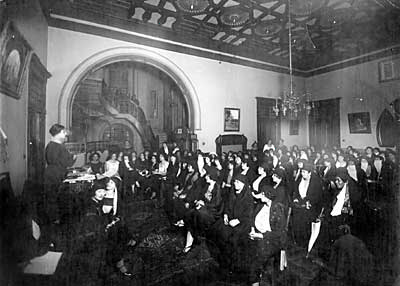Introduction

Feminism is the phenomenon that includes the combinability of political and social movements, notions, and processes which deal with inequalities of gender rights, equal women’s rights. The history of feminism consists of different movements and theories for the rights of women.
The first wave of this phenomenon began in the 19th century and saw the end only in the early 20th century. This period was based on the development of equal women’s rights for their ownership. They also strived for political power, for the right to vote and influence political decisions. This first wave of feminism history covered a great range of women belonging to different groups such as Conservative Christian and Radical groups. Women were provided with the political right to vote at the end of this period.
The second wave lasted up to 1980 and was based on fighting social and cultural rights for women. This phase allowed women to understand the sense of life and their possible rights to act and be involved in the social life of people. The second wave merely deals with the end of discrimination.
The third wave of feminism started in the early 1990s and covered all the aspects of the first and second waves of feminism history. But this wave tries to mild the notion of femininity which is too concentrated on the experience of the white women belonging to the upper-middle-class. The representatives of this period follow the ideology that the notions of gender and sexuality are the central ones; they focused on “micro-politics”. This phase comprises debates between the representatives of different feminism classes: the problem was that some feminists saw the significant differences between the sexes and some of them never considered these differences to be so important. The third wave covers the present time as well. (Humm, 1995, p.251).
Main body
Feminist theory is the embodiment of feminist aspects in the theoretical courses and philosophical fields. This theory helps to understand the ideology of feminism; it centers on gender inequality, sexuality, and gender politics. Feminists discovered the problems of discrimination, stereotyping, and patriarchy. According to the famous feminist and writer Elaine Showalter, the theory includes the following phases:
- Feminist critique (in order to see the ideology of feminism theory);
- Gynocriticism (discovers problems of female creativity);
- Gender theory (the exploration of the sex system and the influence of literary effects on it). (Messer-Davidow, 2002).
Feminism has brought radical changes in society all over the world.
These new rules of the social life included broad employment of women, their full right to divorce by their own will, and to make individual decisions, women had the complete right to their own property. (Harding, 2003) According to the investigations of the research center, the combinability of work done by a woman far outweighs the amount of a man’s work. Every woman does household work together with paid employment and thus performs 20% more tasks than a man. This question was the central one during the meeting of the representatives of the Human Rights Research Center; they began their discussion with such words as “the population of women is about 51%, they perform 66% of all the work, get only about 10% of the total income and have less than 1% of the whole property”. (Bebel, 2004).
The fundamental tasks of the women in the Middle East and Gulf countries completely differed from the views of feminists from the whole world. According to some Islamic sources, the main issue for the female representatives was to study the peculiarities of the religion. The conversion of the countries brought improvements for the women: they got inheritance rights, polygamy was reduced to four wives and they were able to select a community leader. Though new inheritance rights did not make women equal with men, they made a contribution to the development of mysticism. A special place is given to the adoption of Islamic clothing or the veil. This so-called dress of the women from the Middle East is a kind of protest against western intrusion. It highlights the differences between males and females; it is a sign of class discrimination among its wearers. The women of these countries reject the fact the male public notion may be only a patriarchal construct and do not perceive fundamental inequality. The usage of veils in everyday practice by women was a protest against male politics, but with the development of history, the imposition of the veil made an independent women’s movement for their rights on the social and political levels. Women had taken part in the revolution as a part of an independent group rather than as a separate coalition. (Trends in History, 1985).
Their feminism was not only aimed at the creation of independent organizations; the main slogan of their movements was: “women are fewer in number though better in education”. There were two groups of women in those countries:
- those women who followed governmental politics; they were called traditionalists;
- Reformists – women who followed strict rules of the regime.
Some critics put strict contradictions between Islam and Feminism because according to their grounds these notions are incompatible. In the Middle the female population should submit to the male power while they submit to God and to their religion.
East
Islamic and Egyptian feminism is a global phenomenon that always has some space for religion. Egyptian feminist discourse was developed on the basis of an Islamic one. The fundamental argument of feminism is the principle of equality of all human beings described in the Qur’an but the patriarchal ideology subverted the situation. The main methodologies of Islamic feminism are the independent religion investigations and the interpretation of the Qur’an, which devoted a lot of verses to gender equality. (Margot, 2002).

A great contribution to the development of feminist discourse was made by Huda Shaarawi, an Egyptian feminist and nationalist. Her works influenced the women of all Arabic countries. She founded Egyptian Feminist Union and promoted her speeches throughout the world. (Ashby, 1995) Shaarawi created the Intellectual Association of the Egyptian Feminist Union; her views focused on the suffrage of women and changes in the Personal Status Law. All her memories of the feminism in Egypt she described in her work “Harem Years”. (Hatem, 1989).
The women’s self-esteem and independence were ruined by centuries of living in social, cultural, political, and gender inequality. Staying at home and bringing up children are considered to be the only tasks that can be perfectly done by women but they never were interpreted as a “wok”. It is difficult to understand the value of education and the inner development of every woman as a personality in these countries; why they studied and got professions? …or it was just wasting of time, money, and energy?. (Susan, 2003) The notion of feminism never influenced real women’s lives in the Middle East. One can notice the difference in understanding the notion of “independence” by our female population and that of gulf countries. For those women, this notion is rather contradictory: either to be independent of a man and a family or to be a wife and a mother…. Officially women are liberated in active public life, but they are always compared with men; the subordinate position of women is seldom pronounced though it is vitally expressed. (Ahmed, 1992).
Muslim feminist writers such as Mernissi and Ahmed reflected the situation in their works describing the attitude of God to women. According to Mernissi God was not kind to women and described a patriarchal compromise against the female population. In Ahmed’s view, the gender relations were not rough as patriarchy was rather indulgent towards women. (Mernissi, 1991).
Conclusion
The research carried out proves the fact that feminism in the Middle East and Gulf countries differs a lot from the American one where social and gender discrimination was destroyed by strong-willed and independent women who gained their rights and equal position in life. Feminism in the Middle East countries did not leave a print on a happy future of the women; they still have to fight for their rights and independence in making choices, selecting place of job, and influencing the political life of the country on the same level with male population to gain equality in the society.
References
Ahmed, L., 1992, “Women and Gender in Islam: Historical Roots of Modern Debate”, New Haven & London: Yale University Press.
Ashby, Ruth, & Deborah, Gore, 1995, History: Women Who Changed the World, Viking Press, pp. 184-186.
Bebel, August, 2004, “Woman under Socialism”, University Press of the Pacific.
Bracha, Ettinger, 2006 “The Matrixial Borderspace”, Essays from 1994-1999, University of Minnesota Press.
Farrow, Lynne, 2003, “Quiet Rumours: An Anarcha-feminist Reader”, AK Press.
Harding, Sandra, 2003, “The Feminist Standpoint Theory Reader: Intellectual and Political Controversies”, Routledge.
Hatem, Mervat. 1989, Egyptian Upper- and Middle-Class Women’s Early Nationalist Discourses on National Liberation and Peace in Palestine (1922-1944).
Humm, Maggie, 1995, The Dictionary of Feminist Theory, Columbus: Ohio State University Press, p. 251.
Kember, Sarah, 2001. “Resisting the New Evolutionism,” Women: A Cultural Review, Vol. 12, No. 1, pp. 1-8.
Margot, Badran, 2002, Al-Ahram Weekly Online, Issue No.569
Mernissi, F., 1991, “The Veil and the Male Elite: A Feminist Interpretation of Women’s Rights in Islam”, (M. Lakeland, Trans.) New York: Basic Books.
Messer-Davidow, Ellen, 2002, Disciplining feminism: from social activism to academic discourse, Duke University Press.
Susan, Darraj, 2003, “We All Want the Same Things Basically”, Feminism in Arab Women’s Literature Women and Language, Vol. 26.
Information reproduced from TRENDS IN HISTORY, 1985, 4 (1), pp. 49-71.